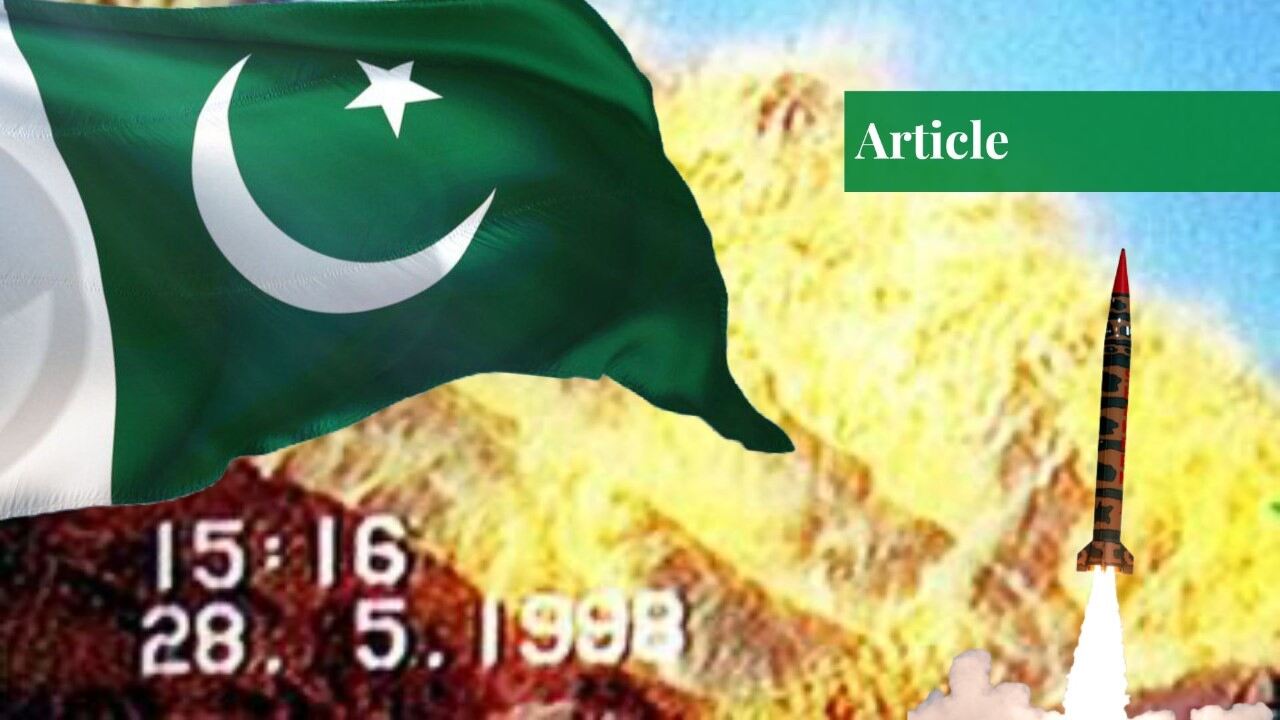Hamra Tariq is an undergraduate student currently pursuing her international relations degree at Kinnaird College for Women, Lahore. She has a keen interest in South Asian politics, the Indo-Pacific, and the shift in the global order.
Introduction
The first twenty-five years after the establishment of the nascent state, the regional security environment prompted Pakistan to pursue such security policies which could deter the threat from its adversarial neighbor, India. The two wars in 1965 and 1971 within a period as short as five years compelled Pakistan towards nuclearization.
Subsequently, the nuclear test by India in 1974 at Pokhran indicated a shift by the West in favor of hostile India; this bolstered Pakistan’s rationale to balance the power in South Asia. Although Pakistan made its decision to work on nuclear weapon technology after the war of 1971, when former President Zulfiqar Ali Bhutto stood adamant on his stance to possess one, the preceding years did influence Pakistan’s strategic culture.
At the time of its independence, Pakistan’s military was in a deplorable state, therefore acquiring a strong military became a prime priority. The majority of the state budget was allocated to the military. Amidst the increasing influence of the military in state affairs and the martial law under General Ayub Khan, the cold war drove the United States to build a partnership in order to counter the Soviet Union. As a result, Pakistan witnessed remarkable growth in its military capabilities.
Along this pathway, a significant blow came with the disintegration of Pakistan’s eastern wing in 1971. In addition, India’s regional hegemonic ambitions made it absolutely necessary for Pakistan to prepare for its security structure keeping a hawkish eye on India. Thus, the conventional means for deterrence soon transformed into a need for a nuclear deterrent.
Pakistan’s Nuclear Program
Pakistan’s civilian nuclear program started in 1956 when it established the Pakistan Atomic Energy Commission (PAEC) following the United States’ Atoms for Peace Proposal presented by President Eisenhower in December 1953. When Bhutto took charge of the Ministry of Fuel, Power and Natural Resources in 1958, he accelerated the nuclear program. Another key figure, Dr. Abdul Salam who was later awarded with the Nobel Award was credited for the growth of PAEC despite living abroad.
Bhutto took charge as the Minister for Foreign Affairs in Ayub Khan’s cabinet. With this increased influence in power circles, Bhutto assessed the security environment of the region concluding that after China’s nuclear test in 1964, India would go for nuclear weapon technology as well. However, unlike Bhutto, Ayub Khan downplayed the prospect of India attaining nuclear technology for military means and continued to work on conventional capabilities until the end of his tenure.
After China’s nuclear tests, Homi Bhabha, the chairman of the Indian Atomic Energy Commission, in his interview tried to reassure his domestic audience and convince India’s political leadership to attain nuclear weapons technology for deterrence. This was the period when Bhutto famously proclaimed, “if India builds the bomb, we will eat grass or leaves, even go hungry, but we will get one of our own.”
Major foreign countries assisted Pakistan to expand its nuclear program. Canada helped Pakistan to install a 137-megawatt heavy water reactor at Karachi Nuclear Power Plant (KANUPP). Similarly, France agreed to set up the Chashma plant. In 1972, after a month of attaining power, Bhutto gathered a number of leading nuclear scientists including Dr Abdul Salam and Dr Ishrat Usmani, the chairman of PAEC, in Multan and pledged to ‘produce a bomb within three years’.
A highly ambitious approach clearly indicated Bhutto’s intentions and commitment. He replaced Usmani and appointed his own handpicked Munir Ahmed as the new chairman of PAEC. Although Usmani was later accused of some serious charges, which were cleared off after investigation, he did lay a foundation for a strong nuclear technology infrastructure. Munir had contacts in IAEA and his aggressive approach on his way to developing a nuclear weapon inspired PAEC.
India’s Nuclearization: Alarm Bells for Pakistan
India tested its first-ever nuclear bomb in 1974, shortly after facilitating a proxy war in East Pakistan in 1971. This so-called ‘Peaceful Nuclear Explosion’ shook the international community. Eventually, Pakistan had to pay the price for non-proliferation decisions made by foreign countries. The Chashma plant commitment by France was never fulfilled and Canada also pulled out of its support in 1976.
Although the international powers restrained from criticizing India at all after it conducted the tests, it is a fact that it was India that initiated the nuclear dimension in the region, not Pakistan. Pakistan formally but secretly took its decision of nuclearization in December 1974 through the plutonium track. In official communication with the United States, Pakistan took a position that its nuclear program was progressing solely for civilian purposes.
During this time, IAEA started to restrict Pakistan’s feasible access to nuclear reprocessing technology, the only additional provision required after the possession of a reactor. Despite the Western hindrances, Pakistan continued the plutonium route. However, the Western roadblocks were not merely limited to strict conditions. Parvez Butt, later the PAEC chairman, proclaimed that foreign powers wanted to completely cripple the nascent nuclear infrastructure.
Dr A. Q. Khan Comes into the Picture
In 1974, during the testing circumstances, Dr Abdul Qadeer Khan, Pakistan’s nuclear scientist based in the Netherlands contacted Bhutto through a letter offering his services for the nuclear program. A. Q. Khan’s credentials caught his attention immediately; his experience at URENCO’s enrichment plant at Almelo had made him learn crucial knowledge about centrifuge-based enrichment technology.
Bhutto advised A. Q. Khan to continue residing in the Netherlands to gather more necessary information required for the program. A. Q. Khan returned to Pakistan in December 1975 where he joined the enrichment project headed by Bashiruddin Mehmood. Under the supervision of Munir Ahmed, Dr. A. Q. Khan was dissatisfied with the pace of the project as well as the incompetence of PAEC. He took the matter to Bhutto and demanded complete administrative autonomy and independence in order to work efficiently.
Bhutto responded positively and decided to hand over complete control of the centrifuge project to A. Q. Khan and separated it under the umbrella of a new institution, the Engineering Research Laboratory (ERL). The project was kept highly secretive; apart from Bhutto, only Ghulam Ishaq Khan was aware of its proceedings.
Meanwhile, the US was highly wary of Pakistan’s nuclear program. Henry Kissinger’s visit and his open warning to Bhutto in clear words of making a ‘horrible example’ out of him if Pakistan did not give up its nuclear program shows the external pressure Pakistan had to face. A year later, Butto was ousted out through a coup led by army chief Zia ul Haq.
Under Zia’s Reign
The nuclear program continued under Zia ul Haq; the URL project was Plan A and the PAEC project was Plan B. The geostrategic location of Pakistan became extremely crucial for the United States as the Soviet Union invaded Afghanistan in 1979. Pakistan did not anticipate this, but this ‘need’ of Pakistan gave an essentially valuable cover for its nuclear program.
Kahuta plant which opened in 1979 started producing substantial quantities of enriched uranium within two years reflecting the determination of A. Q. Khan. ERL was named to Khan Research Laboratory (KRL) by Zia in 1981, recognizing Khan’s efforts. While the nuclear program was at this critical phase, Zia maintained strategic ambiguity about the nuclear program.
The Shah of Iran was ousted in 1979, the same year Afghanistan was taken over by the USSR. The United States could not afford to let go of another ally in the region despite having an idea of where things were headed with Pakistan’s nuclear weapon program. During this phase of the nuclear program, China offered assistance to Pakistan at various levels, including centrifuge equipment, warhead designs, missile systems, and technical expertise.
In addition, for the pursuit of a nuclear deterrent, Pakistan developed negotiating skills with the foreign procurement networks in markets. Simultaneously, Ras Koh Hills in Chagai, Balochistan were chosen as the test explosion sites and by 1980, these sites were ready for a nuclear test.
According to declassified documents of 2012, the Reagan administration had sent CIA deputy director General Vernon Walters to secretly meet with Zia ul Haq in 1982 to communicate reservations, but Zia was very clever with his posture. Walters remarked later on that either Zia was ‘unaware of the facts’ or was the ‘the most patriotic liar I have ever met.’
Both PAEC and KRL succeeded in producing nuclear weapons independently of each other. PAEC conducted its first cold test on March 11, 1983 under the direction of a nuclear scientist, Dr. Samar Mubarakmand. He expressed, “today we realized that we have become a nuclear power, but we could not express it become we were told to keep it a secret.” In parallel, KRL conducted its first cold test in 1984, just a year after PAEC.
Bickering Neighbours
During the 1980s, the relationship between India and Pakistan began to deteriorate. After Israel attacked Oshirak in Iraq in 1981, Pakistan feared a similar preemptive strike from India. In 1984, India planned such an attack but backed off after a public warning from the American ambassador in Pakistan. A single miscalculation from either side could have resulted in a full-fledged war at that time. However, the political leadership of India was not convinced to attack a valuable US ally in the region at a time of great instability; it could have been counterproductive.
After the assassination of Mrs. Gandhi, Rajiv Gandhi took office in 1984. After two years, the daring and exuberant General Krishnaswami Sunderrajan became India’s army chief. The fourth phase of Operation Brasstacks in Rajasthan during October 1986 was aimed to directly threaten Pakistan and force it into a war with a deception of massive force deployment. The issue was dissolved in late January 1987 by some bold diplomacy efforts and US intervention.
The major credit for the de-escalation of tensions is attributed to cricket diplomacy by Zia ul Haq. Zia invited himself to India, and while Rajiv Gandhi was not willing to receive him, his close associates persuaded him.
According to Behramnam, when the two leaders met briefly at the airport lounge, Zia gave a stern warning in the following words, “Mr. Rajiv, you want to attack Pakistan, do it. But keep in mind that because this will not be a conventional war but a nuclear war, this world will forget Halaku Khan and Changez Khan and will only remember Zia ul Haq and Rajiv Gandhi. In this scenario, even if Pakistan is fully destroyed, Muslims will still exist worldwide; yet, if India is destroyed, Hinduism will disappear from the face of the planet.” This left Gandhi stunned.
The Successful Tests
After more than a decade, India conducted its nuclear tests on May 11 and 13, 1998 at Pokhran, Rajasthan. This heavily disturbed the balance of power in South Asia, favouring India. PAEC was called to assess the situation. Headquarters 12 Corps, Quetta was told to secure Chagai Hills. Prime Minister of Pakistan, Nawaz Sharif was on a visit to Uzbekistan, but he cut his visit short and returned to Pakistan the next day. He immediately convened a meeting of the Defence Committee of Cabinet (DCC) calling all stakeholders on board to discuss the security implications of India’s tests.
Pakistan had to face immense foreign pressure, particularly from the US during this time. However, on May 16, Nawaz Sharif conducted another DCC meeting and provided a green signal for the nuclear tests. On May 18, Nawaz Sharif directed the PAEC chairman, Dr. Ishfaq Ahmad to ‘carry out the explosions.’ The site at Chagai was prepared under strict supervision led by Dr. Samar Mubarakmand.
Pakistan decided to level the terror and restore the strategic balance of the region; two weeks after India conducted its tests, at 3:16 pm on May 28, it conducted the nuclear tests at Chagai. Nawaz Sharif in a televised address said, ‘Today, we have settled scores with India and carried out five successful nuclear tests.’ It was nothing short of a miracle, given the circumstances, for Pakistan to successfully reach the stage it did.
The international community did react; it condemned the nuclear tests and sanctioned Pakistan, damaging its already crippling economy. Pakistan had to face the consequences, but it became the first Islamic state to attain nuclearization after surpassing insurmountable challenges along the way.
If you want to submit your articles and/or research papers, please check the Submissions page.
The views and opinions expressed in this article/paper are the author’s own and do not necessarily reflect the editorial position of Paradigm Shift.















